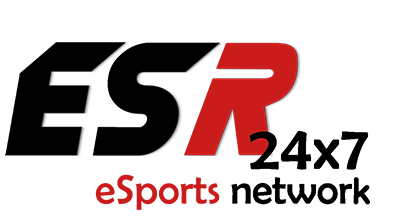ESR Brings eSports to the European Mainstream with Satellite
The eSports market has boomed in recent years, with more and more viewers tuning in to watch their favourite games being played by some of the best gamers in the world. By 2024, there are expected to be almost 286 million eSports enthusiasts worldwide, a vast increase from the 197 million in 2019. However, despite the interest, passion and dedication of its viewership, eSports has yet to truly enter as a mainstream sport. Efforts from ESR and Eutelsat are set to challenge this status-quo and position eSports as a social viewing activity for generations to come - and satellite has presented an opportunity to do so.
With the rise of viewing and playing eSports, broadcasters have risen to the challenge of providing opportunities for fans to watch their favourite games worldwide. These broadcasters, however, have historically remained online, with very few venturing into mainstream television. ESRevolution, or ESR, has risen to this challenge successfully, changing the status-quo of sports American broadcasting in the process. Their next move to expand into Europe, however, presented challenges that only satellite could tackle.
 ESR is a 24/7 TV network that features video game-centric documentaries, talk shows, comedies, and tournaments, including the biggest games and names in eSports. Popular streamers that bring in thousands of views on streaming services like Twitch every day are affiliated with the network. However, ESR does not want to stop at simply appealing to younger, online audiences. ESR’s goal is to bring eSports to mainstream television in much the same way that traditional sports like football are enjoyed for all ages.
ESR is a 24/7 TV network that features video game-centric documentaries, talk shows, comedies, and tournaments, including the biggest games and names in eSports. Popular streamers that bring in thousands of views on streaming services like Twitch every day are affiliated with the network. However, ESR does not want to stop at simply appealing to younger, online audiences. ESR’s goal is to bring eSports to mainstream television in much the same way that traditional sports like football are enjoyed for all ages.
“Depending on the game, our target demographic is from seven years old to thirty-five or older. It’s quite a range, which is why we wanted to adopt traditional TV formats with original content”, says Wendy Wang, CEO of ESR. “The experience of socialising and watching sports on the television is what we want to capture, and as the millennial and gen-z generations get older, the demand for such an experience will only grow.”
ESR was only available in the United States but had plans to expand internationally. One of the first prospects that they considered was the European market. However, the broadcasting challenges of the European market required a different approach to what ESR was used to.
ESR’s plan to expand into Europe began with evaluating whether their approach in the United States would work in Europe. However, they quickly found that broadcasting across Europe posed very different challenges. “While Europe was always our next target for expansion after the United States, it’s very different in terms of the diversity of internet connectivity for each country,” noted Wendy. “Our distribution strategy had to radically change if we wanted to make the impact we sought.”
ESR traditionally used OTT distribution which relies upon high-speed, reliable internet connectivity. Unlike the United States though, many countries did not have sufficient access to resources. “We originally tried to distribute digitally but quickly found that this wasn’t viable. We had difficulties with some countries where the internet infrastructure wasn’t sufficient, or the team was just not ready to receive digital delivery,” says Wendy. “They presented quite a bottleneck that would slow us down in terms of distribution.”
In addition to this, the cost of utilising the internet in many countries would not be cost-effective for widescale broadcasting. To achieve ESR’s mission of breaking eSports into mainstream European television, they would have to consider satellite. As Wendy recalls, “Some of the operators we consulted noted that the cost of internet for broadcasting would be quite expensive. Satellite just made more financial sense.”
To present ESR’s content for a mainstream audience, they needed to access television screens across Europe. Due to the nature of the different country infrastructures and landscapes, satellite distribution was the ideal solution for ESR. The solution in question would need to fulfil ESR’s requirements for cost-effectiveness, reliability, reach and support, and understand the European market. “We considered quite a few satellite providers, but none of them could offer the reach or track record of Eutelsat. They were willing to work with us on pricing and their employees are very professional and knowledgeable,” said Wendy.
Wendy was also highly appreciative of the additional effort Eutelsat put into discovering ESR’s operations and objectives. “I had the pleasure of meeting Eutelsat’s Deputy CEO, Michel Azibert, for breakfast in New York just before the Covid pandemic hit, just before New York was about to lockdown. I believe he caught the last flight back to Paris,” recalls Wendy. “I was very impressed with his vision for the company, and after that breakfast, I felt like I really wanted to do business with Eutelsat.”
Amidst the pandemic, Eutelsat set to work to introduce ESR to the European market. Eutelsat used the signal from an existing United States vendor who was partnered with Eutelsat already to set ESR up in record time. “The setup process was extremely easy. It was quick and smooth, so we were very pleased with how simple Eutelsat made the process for us,” says Wendy.
In February 2021, ESR began to broadcast their content across Europe, but that did not conclude Eutelsat’s support for the channel. “Since before we signed the agreement, to after the channel went live, their sales team are constantly engaged with us, providing leads, advice and distribution strategy. The marketing team has been very helpful too, creating releases, content and insights for us to use,” says Wendy. “Eutelsat is doing everything to ensure this partnership is successful, and we feel the same passion.”
ESR now reaches 135 million homes across Europe and MENA through Eutelsat’s HOTBIRD satellite. Its ground-breaking format attracts a new generation of younger audiences and illustrates that linear distribution via satellite is attractive for new channel genres to multiply and diversify their distribution. ESR has continued to work with Eutelsat to continuous positive feedback from audiences.
“What’s really impressive to me is that Eutelsat is a very large, publicly-traded company, but they run the company with a can-do attitude. They are very flexible, accommodating and enthusiastic, which is very rare for a company of that size,” says Wendy. “I’m really excited to work with them, and I think we have a great team to increase our footprint across Europe, The Middle East and Africa.”
ESR plans to continue expanding across the world, showcasing premium eSports and gaming content. Due to the benefits and success of their recent satellite launch in Europe, they now know that satellite distribution is a viable option.
“Our success with Eutelsat has proven that satellite distribution is a viable alternative for new media. We will definitely consider using Eutelsat for our future launches as we expand to new territories around the world,” concludes Wendy.
If you would like to find out more about how Eutelsat can support your own broadcasting needs, visit our website for more information, or contact us today.



